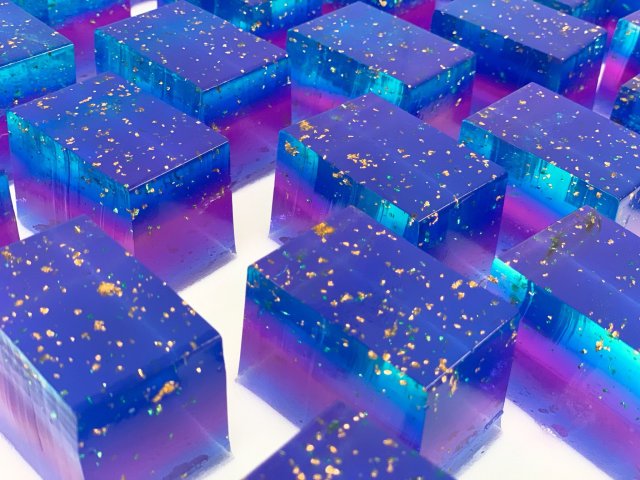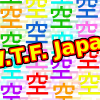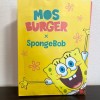
We don’t wish upon a star in this house — we eat them instead.
Every year July 7 marks the start of Tanabata: a festival celebrating the reunion of Japanese celestial deities Orihime and and Hikoboshi, respectively represented by the stars Vega and Altair.
The festival originates from the Chinese folk tale “The Silk Weaver and the Cowherd” and incorporates the tradition of hanging a paper with one’s written wishes on bamboo stalks. While these star-crossed lovers use the Milky Way to meet once every summer, us mortals have the more delicious option of eating the Milky Way instead.
With traditional Japanese sweets shop Oumiya (@oumiya_toyota), based in Toyota city in Aichi prefecture, you can eat the Milky Way as a piece of traditional Japanese confection, otherwise known as wagashi.
近江屋の上生菓子【天の川】
— 菓舗 近江屋 (@oumiya_toyota) June 30, 2020
錦玉制
レモン果汁入り
天の川を手の平に表現するイメージで作りました^o^
星雲を表すために色々と工夫しております!
まずは目で小さな天の川を堪能して
最後は口の中でほんのりレモン味の織姫、彦星の恋愛模様をご堪能下さい。#天の川 #和菓子 #近江屋 pic.twitter.com/HewLdp22R7
“New Oumiya Wagashi Debut
【Milky Way】Done in kingyoku style and flavored with lemon juice, we created a rendition of the Milky Way that can fit into the cusp of your palm! We used multiple colors to imitate the heavenly clouds. First, be sure to enjoy the gorgeous colors with your eyes, and then lastly, enjoy the subtle taste of lemon representing Orihime and Hikoboshi’s bittersweet love with your mouth.”
Gold flecks imitate the shining brilliance of stars, and the vivid spectrum of a blue gradient seeping into deep purple serve as a delight for the senses. The “Milky Way” wagashi’s beauty is further accentuated by the see-through nature of its kingyoku style.
Kingyoku, literally comprised of the Japanese characters for “brocade” and “sphere,” is a style of translucent sweets made by mixing heated agar and sugar, then cooling them until they harden. This specific style is popular for traditional Japanese summer sweets due to their higher water content and refreshing appearance.
▼ Besides kingyoku-style wagashi, Oumiya has several high-quality, novel wagashi creations debuting this summer such as this homage to Van Gogh…
近江屋の上生菓子
— 菓舗 近江屋 (@oumiya_toyota) July 1, 2020
【ゴッホのひまわり】
ゴッホのひまわりをイメージしたお菓子を作りました(^。^)
ゴッホの色使い、重厚な筆のタッチに感動しました!
是非ご賞味下さい(๑˃̵ᴗ˂̵)#近江屋 #ゴッホ #ひまわり pic.twitter.com/MVnmNa1CcI
“New Oumiya Wagashi Debut
【Van Gogh’s Sunflower】We were inspired by Van Gogh’s paintings of sunflowers, and tried to capture the spirit of his paintings by using Van Gogh’s colors and brush strokes. Definitely take your time to absorb all the details!”
▼ …a fireworks-inspired wagashi…
近江屋の上生菓子
— 菓舗 近江屋 (@oumiya_toyota) June 26, 2020
【おいでん花火】
今年は地元の花火祭り、おいでん花火大会が中止になってしまい、豊田の夏の風物詩が無くなってしまいました…
なので和菓子を通して少しでも夏の夜空を感じて頂けたらと思い作りました。
数量限定ですのでお早めにお買い求め下さい😊#近江屋 #おいでん #花火 pic.twitter.com/xJxCH4oNwy
“New Oumiya Wagashi Debut
【Oiden Fireworks】(Note: Oiden Matsuri is an annual summer fireworks festival in Toyota city.)Though the local fireworks festival for this year was canceled, we decided to make this wagashi to inspire a feeling of summer nights. Because these are only available in limited quality, be sure to swing through soon!
▼ …and this sugary interpretation of fireflies drifting through tall grass.
近江屋の上生菓子【蛍火】
— 菓舗 近江屋 (@oumiya_toyota) June 5, 2020
黒糖錦玉製
夜に光るホタルを表現しました^o^
使用した高知県産の黒糖は優しい甘さでクセのないスッキリした味わいが特長です。お抹茶の味を引き立てる上生菓子にぴったりな黒糖です^o^
是非ご賞味下さい^o^#近江屋 #蛍 #黒糖 pic.twitter.com/u8yrzGfMzP
“New Oumiya Wagashi Debut
【Glowing Fireflies】Made with agar mixed with black sugar. We wanted to create a sweet that depicts glowing fireflies at night. To create this one, we sourced our black sugar from a local producer in Kouchi prefecture for an impeccable, distinctive sweet taste. This is a special wagashi with black sugar that almost tastes like matcha!”
While many of Oumiya’s newest lineups include sweets depicting traditional Japanese summer motifs, some of Oumiya’s summer wagashi are also more on the playful side, such as these tongue-in-cheek ones imitating grilled corn and mosquito-repelling incense.
近江屋の上生菓子
— 菓舗 近江屋 (@oumiya_toyota) July 10, 2020
【とうもろこし】
練り切り製
夏野菜の一つのとうもろこしを作りました🌽
個人的に塩茹でして醤油塗って表面を焼くのが一番好きです^o^
幼い時は、とうもころしってずっと言ってました笑
是非旬の和菓子をご賞味下さい😀#近江屋 #とうもろこし #和菓子 pic.twitter.com/Qw0C1R17S9
“New Oumiya Wagashi Debut
【Corn】
Made in nerikeri style. (Note: A style of wagashi that uses sweet bean paste mixed with either sticky rice flour or mountain yam.) We made one of summer’s most iconic vegetables in wagashi form: the corn.”
▼ Not going to lie, eating sweets in the form of mosquito-repelling incense wasn’t a priority on my bucket list, but it looks pretty darn tasty.
近江屋の上生菓子
— 菓舗 近江屋 (@oumiya_toyota) July 8, 2020
【夏の日】
練り切り製
今は全く見ませんが蚊取線香を入れる例のアレを作りました^o^
夏休み、祖父母の家に行った時、縁側にこれが置いてあり、うちわで煽ぎながらポッキンアイスを食べてたなー
懐かしい!!#近江屋 #夏 #夏の風物詩 pic.twitter.com/SSi8jIQE2M
“New Oumiya Wagashi Debut
【One Summer Day】Made in nerikeri style. Though now you don’t see them at all, we’ve decided to make a wagashi in the shape of a mosquito coil holder. On a more personal note, during summer vacation, whenever I visited my grandparents, there’d always be a mosquito coil set on the veranda where we’d sit fanning ourselves while eating ice popsicles. This wagashi certainly brought back nostalgic memories!”
Oumiya doesn’t only just make seasonal wagashi. The 80-year-old sweets shop was able to create wagashi for the times with their rendition of amabie, a supernatural creature in Japanese folklore believed to protect against disease.
▼ Instead of scales, Oumiya opted for stripes to give a pop of color to the amabie.
明日もアマビエ様が近江屋にお見えになります!
— 菓舗 近江屋 (@oumiya_toyota) May 30, 2020
しかし、今回でアマビエ様にはお休みになって頂きます^o^
今までありがとうございました😊
アマビエ様のお力を借りなくてもすむような世界になりますように!!#近江屋 #アマビエ様 pic.twitter.com/UhUQdbPVfX
“Tomorrow as well the Great Amabie will come through our humble store!
However, this time the Great Amabie will be stopping to take a rest.
Thank you for everything so far, and we hope the world will be healed of COVID-19 soon, even without the Great Amabie’s help!”
Oumiya isn’t the first store to create sweets inspired by amabie’s image, but it’s heartwarming to know how this well-established, locally-owned wagashi shop strives to spread positivity during an uncertain time, especially with their creative takes on the traditional form of Japanese sweets.
And if you really like Japanese sweets, then you can wear them too, with Nike’s Air Wagashi line!
Source, images: Twitter/@oumiya_toyota
● Want to hear about SoraNews24’s latest articles as soon as they’re published? Follow us on Facebook and Twitter!
 We spend a morning with an expert wagashi chef creating no-bake traditional Japanese sweets!
We spend a morning with an expert wagashi chef creating no-bake traditional Japanese sweets! Air Wagashi: New Nike Air Max sneakers are the delicious kicks we’ve all been waiting for
Air Wagashi: New Nike Air Max sneakers are the delicious kicks we’ve all been waiting for Make your own “wagashi” Japanese sweets at home with these creation kits
Make your own “wagashi” Japanese sweets at home with these creation kits Godiva releases first-ever yokan to celebrate 50th anniversary in Japan
Godiva releases first-ever yokan to celebrate 50th anniversary in Japan Enjoy beautiful Japanese snacks and tea at Saryo Fukucha in Kyoto
Enjoy beautiful Japanese snacks and tea at Saryo Fukucha in Kyoto Foreigner’s request for help in Tokyo makes us sad for the state of society
Foreigner’s request for help in Tokyo makes us sad for the state of society Bad tourist manners at Mt Fuji Lawson photo spot prompts Japanese town to block view with screens
Bad tourist manners at Mt Fuji Lawson photo spot prompts Japanese town to block view with screens One of Japan’s oldest castles now lets travelers spend night on the grounds, drink in its keep
One of Japan’s oldest castles now lets travelers spend night on the grounds, drink in its keep McDonald’s Japan’s new pancake pie is a taste sensation
McDonald’s Japan’s new pancake pie is a taste sensation Two things to do, and two things not to do, when leaving a traditional Japanese inn
Two things to do, and two things not to do, when leaving a traditional Japanese inn W.T.F. Japan: The top five “sora” references of all time! 【Weird Top Five】
W.T.F. Japan: The top five “sora” references of all time! 【Weird Top Five】 Mikado Coffee is a 76-year-old coffee chain with a major celebrity connection
Mikado Coffee is a 76-year-old coffee chain with a major celebrity connection Studio Ghibli unveils massive T-shirt collection featuring top anime movie characters
Studio Ghibli unveils massive T-shirt collection featuring top anime movie characters Studio Ghibli unveils new goods that tip the hat to The Cat Returns
Studio Ghibli unveils new goods that tip the hat to The Cat Returns Spring Mos Burger x SpongeBob lucky bags bring us fun under the sun【Photos】
Spring Mos Burger x SpongeBob lucky bags bring us fun under the sun【Photos】 Japanese ramen restaurants under pressure from new yen banknotes
Japanese ramen restaurants under pressure from new yen banknotes Red light district sushi restaurant in Tokyo shows us just how wrong we were about it
Red light district sushi restaurant in Tokyo shows us just how wrong we were about it McDonald’s new Happy Meals offer up cute and practical Sanrio lifestyle goods
McDonald’s new Happy Meals offer up cute and practical Sanrio lifestyle goods Tokyo Tsukiji fish market site to be redeveloped with 50,000-seat stadium, hotel, shopping center
Tokyo Tsukiji fish market site to be redeveloped with 50,000-seat stadium, hotel, shopping center Japanese city loses residents’ personal data, which was on paper being transported on a windy day
Japanese city loses residents’ personal data, which was on paper being transported on a windy day Beautiful Red and Blue Star luxury trains set to be Japan’s new Hokkaido travel stars
Beautiful Red and Blue Star luxury trains set to be Japan’s new Hokkaido travel stars Ghibli Park now selling “Grilled Frogs” from food cart in Valley of Witches
Ghibli Park now selling “Grilled Frogs” from food cart in Valley of Witches New definition of “Japanese whiskey” goes into effect to prevent fakes from fooling overseas buyers
New definition of “Japanese whiskey” goes into effect to prevent fakes from fooling overseas buyers Our Japanese reporter visits Costco in the U.S., finds super American and very Japanese things
Our Japanese reporter visits Costco in the U.S., finds super American and very Japanese things All-you-can-drink Starbucks and amazing views part of Tokyo’s new 170 meter-high sky lounge
All-you-can-drink Starbucks and amazing views part of Tokyo’s new 170 meter-high sky lounge More foreign tourists than ever before in history visited Japan last month
More foreign tourists than ever before in history visited Japan last month New Pokémon cakes let you eat your way through Pikachu and all the Eevee evolutions
New Pokémon cakes let you eat your way through Pikachu and all the Eevee evolutions Disney princesses get official manga makeovers for Manga Princess Cafe opening in Tokyo
Disney princesses get official manga makeovers for Manga Princess Cafe opening in Tokyo We try out “Chan Ramen”, an underground type of ramen popular in the ramen community
We try out “Chan Ramen”, an underground type of ramen popular in the ramen community Sales of Japan’s most convenient train ticket/shopping payment cards suspended indefinitely
Sales of Japan’s most convenient train ticket/shopping payment cards suspended indefinitely Sold-out Studio Ghibli desktop humidifiers are back so Totoro can help you through the dry season
Sold-out Studio Ghibli desktop humidifiers are back so Totoro can help you through the dry season Japanese government to make first change to romanization spelling rules since the 1950s
Japanese government to make first change to romanization spelling rules since the 1950s Ghibli founders Toshio Suzuki and Hayao Miyazaki contribute to Japanese whisky Totoro label design
Ghibli founders Toshio Suzuki and Hayao Miyazaki contribute to Japanese whisky Totoro label design Doraemon found buried at sea as scene from 1993 anime becomes real life【Photos】
Doraemon found buried at sea as scene from 1993 anime becomes real life【Photos】 Tokyo’s most famous Starbucks is closed
Tokyo’s most famous Starbucks is closed One Piece characters’ nationalities revealed, but fans have mixed opinions
One Piece characters’ nationalities revealed, but fans have mixed opinions We asked a Uniqlo employee what four things we should buy and their suggestions didn’t disappoint
We asked a Uniqlo employee what four things we should buy and their suggestions didn’t disappoint Wagashi chef crafts amazing edible characters with leftover scraps 【Photos】
Wagashi chef crafts amazing edible characters with leftover scraps 【Photos】 Love Japanese yokai? You’ll love these Halloween-only yokai Japanese confectionaries
Love Japanese yokai? You’ll love these Halloween-only yokai Japanese confectionaries Why do Japanese hot spring inns give you tea and sweets at check-in? For your own safety
Why do Japanese hot spring inns give you tea and sweets at check-in? For your own safety Kyoto’s newest Shinkansen souvenir: Canned cakes filled with matcha and cherry blossoms
Kyoto’s newest Shinkansen souvenir: Canned cakes filled with matcha and cherry blossoms Make your own Japanese manju snacks with hotcake mix【SoraKitchen】
Make your own Japanese manju snacks with hotcake mix【SoraKitchen】 We became Japanese sweet chefs for a day with Popin Cooking’s DIY wagashi set
We became Japanese sweet chefs for a day with Popin Cooking’s DIY wagashi set Castella cake ice cream debuts in Japan, and it’s one of the strangest things we’ve ever tasted
Castella cake ice cream debuts in Japan, and it’s one of the strangest things we’ve ever tasted Details of the Pokémon/Van Gogh art museum crossover are just as adorable as we’d hoped【Pics】
Details of the Pokémon/Van Gogh art museum crossover are just as adorable as we’d hoped【Pics】 Mr. Sato eats a Japanese sweet potato brulée so good that it just about knocks his socks off
Mr. Sato eats a Japanese sweet potato brulée so good that it just about knocks his socks off Pokémon and 158-year-old Kyoto sweets shop team up for Pokémon wagashi confectionery line【Pics】
Pokémon and 158-year-old Kyoto sweets shop team up for Pokémon wagashi confectionery line【Pics】  BBQ bug-free and in style with cute new bug-repellent coil stands, just in time for summer
BBQ bug-free and in style with cute new bug-repellent coil stands, just in time for summer Japanese confectionery store Toraya serves up a surprising meal in Paris
Japanese confectionery store Toraya serves up a surprising meal in Paris Robot performs traditional Japanese tea ceremony, serves up frothy matcha in seconds 【Video】
Robot performs traditional Japanese tea ceremony, serves up frothy matcha in seconds 【Video】 Invasion of the moon rabbits: the delicious tradition of otsukimi 【Photos】
Invasion of the moon rabbits: the delicious tradition of otsukimi 【Photos】 The first restaurant in Japan to serve anmitsu sweets is still in business and still amazing
The first restaurant in Japan to serve anmitsu sweets is still in business and still amazing Maybelline and Furifu release a retro-modern “Traditions of Japan” yukata collection
Maybelline and Furifu release a retro-modern “Traditions of Japan” yukata collection
Leave a Reply